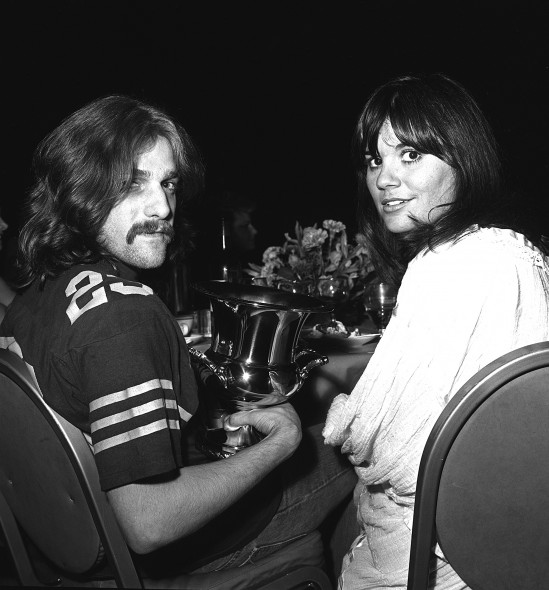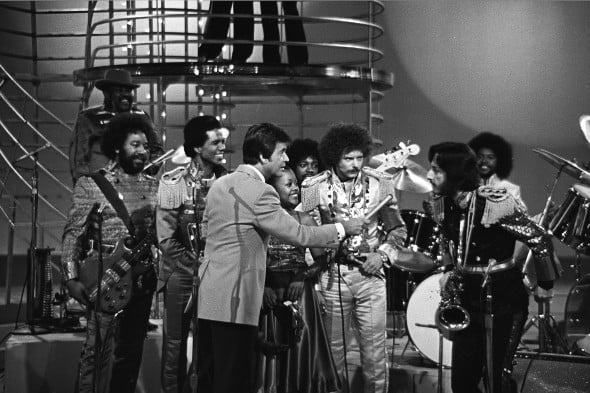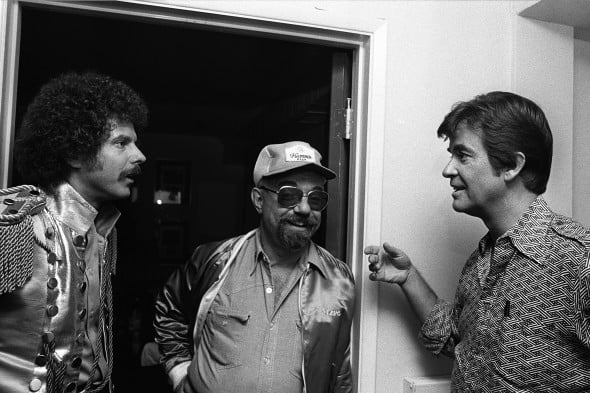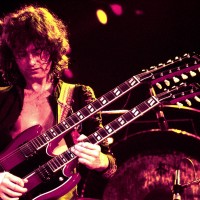The Passing of a Legend
We’ve lost a few icons lately. Lemmy from Motorhead. David Bowie.
I got my start in and around Southern California in the mid 1960’s. After the moodiness of The Doors and the majesty of Led Zeppelin, the region became a hotbed of young, enthusiastic singers and songwriters. They developed a signature sound that still resonates today. Two people who epitomized that sound were Linda Ronstadt and Glenn Frey of The Eagles. We lost Frey last week, and he will be missed. I was able to catch the two of them together in 1977.
Its Got A Good Beat and I Can Dance To It
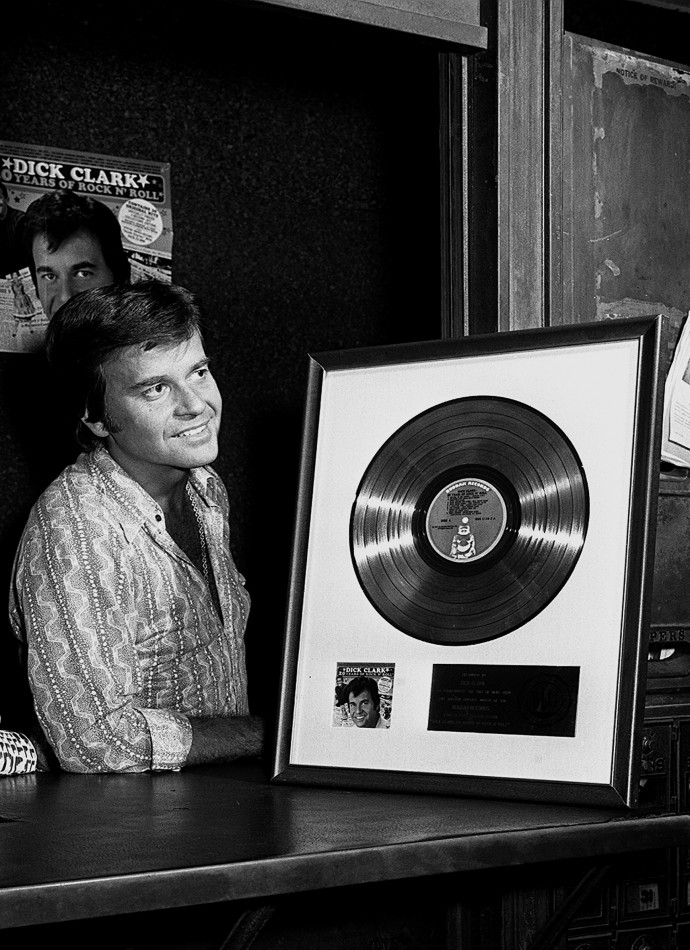 If you’re a fan of Rock & Roll then you’ve heard of Dick Clark. “America’s Teenager”, “World’s Oldest Teenager”, Host of New Year’s Rockin’ Eve, $10,000 Pyramid, and for three decades the face of rock music.
If you’re a fan of Rock & Roll then you’ve heard of Dick Clark. “America’s Teenager”, “World’s Oldest Teenager”, Host of New Year’s Rockin’ Eve, $10,000 Pyramid, and for three decades the face of rock music.
Dick Clark was a young disc jockey in Philadelphia when the host of a popular show, Bob Horn’s Bandstand, was fired. Clark was a regular substitute for Horn, and made the show his own. It was picked up by ABC, and American Bandstand debuted on August 5, 1957 with an interview of Elvis Presley. While to many he defined a movement, according to Clark, “I played records, the kids danced, and America watched.” Pretty typical understatement of Clark.
American Bandstand brought artists to living rooms across the nation well before the age of MTV (which used to show videos), YouTube, and the like. When he broke the color barrier with Chuck Berry, many were surprised to see that the duck-walking artist was black. Soon enough, he was regularly featuring mixed race bands, had teenagers of all races sitting together in the audience, and contrary to the standards of the time, dancing together.
In addition to millions of youngsters being introduced to the latest dance craze, he was the first to feature such artists as The 5th Dimension, The Animals, Blondie, Bill Withers, Tina Turner, The Village People, and The Sugarhill Gang. He featured a live appearance each week, and hundreds of artists over thirty+ years were introduced to rocking Americans on the show. An appearance on his show was often the “break” a new band was hoping for, and performing on American Bandstand with a fresh-faced youngster proclaiming, “Its got a good beat and I can dance to it” would send people running to the record store. In an iconic moment, he invited a new band to perform with an untested lead singer, a young Michael Jackson. It was 1970. Clark still had over forty years to rock.
I had done some work with The Doors (American Bandstand 1967) and was introduced to Dick Clark through some common friends. He invited me to his office, Dick Clark Productions, in 1975. It was on the Sunset Strip in Los Angeles, then the center of the rock world. It was also, ironically, just blocks from where I had met The Doors at their studio. Clark was warm, gracious, and funny. Everything that has been said about him is true. One of the nicest people that I’ve ever met in the music business, and I’ve met a lot of them, from the reserved John Paul Jones of Led Zeppelin to his over-the-top manager Peter Grant, the bathrobe wearing Brian Wilson of the Beach Boys to the “come on over; we’re in the pool” of Paul McCartney. Clark was a king among them, and forever thankful for the opportunity and respectful of his place in rock history.
I was invited back in 1977. I had gotten to know a fantastic band called WAR (Cisco Kid, Low Rider, Why Can’t We Be Friends?) when they were fronted by Eric Burdon of The Animals. Burdon had left the band by this point, but I got to spend a day at American Bandstand with WAR and Clark.
Rock & Roll still has a good beat, and we’re still dancing to it. Thanks, Dick.
40 Years Ago Today
It was 40 years ago today, November 8, 1971, that Led Zeppelin released their long-awaited followup to Led Zeppelin III, the appropriately named Led Zeppelin IV (It wasn’t until 1973’s Houses of the Holy that they actually named the albums). It featured “Black Dog”, “Rock and Roll”, “The Battle of Evermore”, “Stairway to Heaven”, “Misty Mountain Hop”, “Four Sticks”, “Going to California”, and “When the Levee Breaks”. The recording sessions also produced “Down By the Seaside”, “Night Flight”, and “Boogie With Stu”, but they didn’t make the album.
The decision to not name the album was a conscious one. They didn’t want to trade on the “commercial entity” that had become Led Zeppelin. Even the image on the outer sleeve was a commentary on commercialism: An old man and a city in decay. It was, according to Page, “a way of saying that we should look after the earth, not rape and pillage it.” While it peaked at #2 on the U.S. charts, it became the biggest and most durable seller in their catalog. 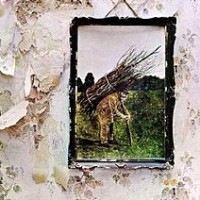
I was able to meet and work with Led Zeppelin many times during their career and this period was particularly exciting and fruitful. I can remember them doing a stretch at The Forum in Inglewood, California. I shot many concerts at the Forum, but shooting Led Zeppelin’s were like working in a room full of static electricity: hair constantly standing straight up. They sold out both nights at The Forum in about 3 1/2 hours. Keep in mind, this was before the Internet and smart phones!
Call it Led Zeppelin IV, or The Fourth, or The Four Symbols, or The Hermit. The name doesn’t really matter. It was and is Rock and Roll, and I call it one of the best albums ever created.
It Was Never Quiet at the Riot Hyatt
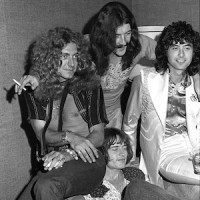 I got a phone call on a quiet Monday in February of 1973 from Led Zeppelin’s publicist. I had been working the rounds in Los Angeles and between the PR guys and record companies I had made a few good contacts. I had run into the publicist for Led Zeppelin a few weeks earlier and asked if I could have some time with the band the next time that they were in town.
I got a phone call on a quiet Monday in February of 1973 from Led Zeppelin’s publicist. I had been working the rounds in Los Angeles and between the PR guys and record companies I had made a few good contacts. I had run into the publicist for Led Zeppelin a few weeks earlier and asked if I could have some time with the band the next time that they were in town.
The band had just come from a tour of England and was taking a month to relax before starting a big U.S. tour. They had four eponymous albums on the charts and were waiting for the release of number 5, Houses of the Holy. The album had hits in No Quarter and The Song Remains the Same. While it departed from much of their blues influences it had funky tracks in The Ocean and D’yer Mak’er. It also had a beautiful acoustic based track, The Rain Song. Much of the initial buzz, however, was about the risqué cover featuring young, naked children.
The call from Zeppelin’s people invited me to meet them at The Continental Hyatt House on the Sunset Strip. The Continental Hyatt had become a base of operations for many up and coming bands as it was close to the Whiskey-A-Go-Go and the many clubs and recording studios in West Hollywood. After spending a few evenings with bands at the Hyatt my friends and I began calling it The Continental Riot House. Led Zeppelin did much to bring about this nickname.
The lads of Zeppelin would typically rent out several entire floors for their antics. Keith Richards became famous for throwing a television out of one of the windows. Keith Moon threw a larger one out of one of the windows. Never one to be outdone, John Bonham liked to unwind with a ride on a Harley Davidson…down the hallways between the suites. Orgies with Jimmy Page, groupies chasing Robert Plant, John Paul Jones’ reserved debauchery, to Bonham being Bonzo; if you’ve read it it’s probably true.
I had hoped to catch the band for dinner and establish a rapport but when I arrived at 6:30 the night’s revelries were obviously well under way. I followed a hotel bartender with a crate of liquor and found a mostly incoherent Robert Plant holding court. I started talking to him about my ideas for some shots but found myself getting nowhere so after a half hour or so I grabbed a drink myself.
I had just about given up on an organized shoot when Peter Grant lumbered in. At 6 foot 5 and well over 350 pounds, I knew Grant’s reputation for getting things done and enlisted his help in making photography happen. 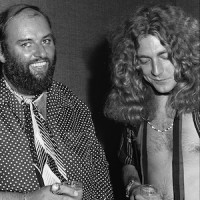
Any pictures of the band that I had seen up until this point had either been stage shots or big horizontal panoramas and I began looking for props to create something different. I found an ugly orange armchair in one of the rooms and asked Grant to help me round up the lads. My idea was a vertical grouping of the band. Newspapers and magazines would love it for the ease of a print layout and it was different than all of the other photos that I’d seen.
Plant and Page arrived and mulled participation. Jones was in another mood and Grant physically put him in place for me. Page and Plant began laughing and plopped down on either arm of the chair. Seeming to sense that he was being left out, Bonham wandered in, smoking a cigarette, and threw his arms around them.
I began furiously working my two cameras, an old favorite loaded with color and my newer Nikon with black and white. I managed to get almost 20 shots before the peace dissolved and chaos returned.
A few days later I was able to get my shots to Led Zeppelin’s publicist and they chose one of the black and whites. Through them I was contacted by Grant who made an offer to buy the whole lot of the color shots. He wanted to buy them all but I saved the best one and never showed it to them.
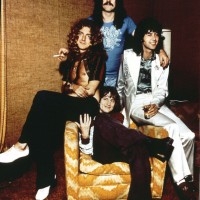 Since that night I’ve gone on to see the black and white in numerous books about Led Zeppelin. It’s been in magazines and even VH1’s Behind the Music. I’ve had a devil of a time tracking down publishers and receiving photographer credits but one thing is for sure. None of those guys ever had an evening like mine with Led Zeppelin at the Continental Riot House.
Since that night I’ve gone on to see the black and white in numerous books about Led Zeppelin. It’s been in magazines and even VH1’s Behind the Music. I’ve had a devil of a time tracking down publishers and receiving photographer credits but one thing is for sure. None of those guys ever had an evening like mine with Led Zeppelin at the Continental Riot House.
James Fortune Photos at the Rock Art Show!
 VERY pleased to announce that some James Fortune photography will be featured this year at the Rock Art Show in Atlantic City. The show runs in cities across the country each year, and is known for bringing together an awesome mix of photography, drawn and painted pieces, posters, and memorabilia like gold records and handwritten lyrics.
VERY pleased to announce that some James Fortune photography will be featured this year at the Rock Art Show in Atlantic City. The show runs in cities across the country each year, and is known for bringing together an awesome mix of photography, drawn and painted pieces, posters, and memorabilia like gold records and handwritten lyrics.
The Rock Art Show has a great history – many big rock names have attended over the years and the show has been featured on many major news outlets like CNN, Entertainment Tonight, and E!. They’ve also done some great service work – during its first five years the show raised over a million dollars for charity.
James will be at the show in person along with some of his most iconic rock photographs during the Atlantic City stop of the show’s tour this year. Included among James’ work featured will be many of the same shots admitted to the Rock and Roll Hall of Fame collection. The event will take place on Sunday, June 26, at the Trump Plaza Hotel.
Metro Space Gallery Featuring Legendary Rock Photographer James Fortune Sept 3rd, 2010
 Richmond, VA September 3rd, 2010 | Metro Space Gallery will be kicking off this fall’s First Friday Art Walk with the incredible photography of James Fortune. The event will begin at 6PM and will showcase Fortune’s journey during the 1970s side-by-side some of the world’s most influential musicians of all time.
Richmond, VA September 3rd, 2010 | Metro Space Gallery will be kicking off this fall’s First Friday Art Walk with the incredible photography of James Fortune. The event will begin at 6PM and will showcase Fortune’s journey during the 1970s side-by-side some of the world’s most influential musicians of all time.
Fortune began his career in the late ‘60s, his first assignment as a photographer was to photograph a certain up-and-coming new band from LA called “The Doors”. From that point forth he became a regular fixture at some of the nation’s biggest music events and hanging backstage with icons like Mick Jagger, Paul McCartney, Robert Plant, Jim Morrison, Elton John and countless others. Fortune’s photography was of such high caliber that he was recruited as Led Zeppelin’s main photographer and was granted an all-access pass which resulted in capturing insightful, candid photos, some of which will be available for sale autographed at the Metro Space Gallery.
James Fortune’s work will certainly go down in history as some of the most poignant shots in rock-n-roll. Fortune looks forward to meeting new and old fans of his work tomorrow night at Metro Space Gallery, located at 119 W Broad St Richmond, Virginia 23220.
Jim Morrison and The Doors – When The Music’s Over
 In 1967 I was in my second year at college in Woodland Hills, California. About twenty miles north of Hollywood – the entertainment capital of the world. I was the photo editor of the college newspaper “The Roundup”.
In 1967 I was in my second year at college in Woodland Hills, California. About twenty miles north of Hollywood – the entertainment capital of the world. I was the photo editor of the college newspaper “The Roundup”.
One day in the darkroom while I was developing a roll of film I thought I came up with a great idea. I called a few record companies and asked if I could, with a journalist student friend, interview and photograph a few of their rock and roll bands. Plus, I wanted some free records.
To my surprise Elektra Records was one of the first record companies to return my call. They asked if I would like to go into the recording studio to photograph this new group… The Doors. The group was in the middle of recording their second album “Strange Days”. At this time in April of 1967 was when I first heard of a group called The Doors. A DJ named Dave Diamond was the only DJ in Los Angeles playing a seven minute song called “Light My Fire”.
Early one afternoon in May I arrived at Sunset Sound Recording Studios. I remember being a bit nervous. When we pulled into the parking lot of Sunset Sound Recording Studio we found Jim Morrison leaning on the gray brick wall and staring right at us. For the most part I just wanted to stay in the background, taking a few wide angle photos of the band working and tuning their instruments.
The Doors had solidly established themselves as the hottest group in Los Angeles. As we said hello to Morrison we went inside the recording studio and introduced ourselves to Paul Rothchild, The Doors producer. Things were getting exciting.
As we sat down in the control room, the instrumental for “I Can’t See Your Face In My Mind” was being played back. The music spilled into the room from several large stereo speakers mounted over the picture window that divided the recording studio. When Paul Rothchild had Jim record his voice over the rich textured music, Morrison liked the lights turned low as he sang the song. Ray Manzarek had said in an interview that The Doors message was simple: “Just groove. To groove to the music.” That was The Doors mantra and it was true.
After a few hours Paul Rothchild called for a break and we went outside on Sunset Boulevard and I was able to get a few photos of the band on Sunset Boulevard.
I went on to photograph the band two more times. The last concert I photographed The Doors was May 1968 at the Santa Monica Civic Auditorium.
James Fortune At The Night Of Heroes
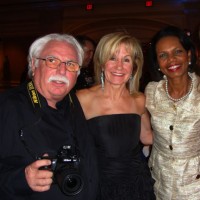 The Pentagon Federal Credit Union Foundation held its annual Night of Heroes Gala on Thursday, June 3, 2010 at the Ritz-Carlton, Washington, DC. This year, the Night of Heroes honored the Intelligence and Special Operations communities.
The Pentagon Federal Credit Union Foundation held its annual Night of Heroes Gala on Thursday, June 3, 2010 at the Ritz-Carlton, Washington, DC. This year, the Night of Heroes honored the Intelligence and Special Operations communities.
James Fortune has been the honorary photographer for the event and generously donates previous photographs of famous individuals for auction.
In addition to corporate, political and military guests were wounded patients from Walter Reed Army Medical Center and Bethesda National Naval Medical Center and residents from the Armed Forces Retirement Home. The keynote speech was given by The Honorable Condoleezza Rice, 66th U.S. Secretary of State. The awards were presented by General Barry McCaffrey USA (Ret).
James had the rare opportunity to get in front of the camera for a quick picture with the former Secretary of State, Condoleezza Rice. It was a fabulous night for all who attended!
James Fortune Featured In The Washington Post


James Fortune Photography was featured in The Washington Post! Featuring the photos of Robert Plant holding a dove in his hand and Iggy Pop after a gig at the Whisky a Go-Go.
Stuck in the same time warp but at the other end of the spectrum is “Rock & Roll Icons of the ’60s and ’70s: James Fortune Photographs,” an All Rogers Gallery exhibition of portraiture by prolific chronicler of rock royalty James Fortune…
Go to The Washington Post website to read the rest of this article.
Celtic Moon Sign For Jimmy Page
Jimmy Page, the founder of one of biggest bands of all time, Led Zeppelin, was born January 9th as a Capricorn, and under the Birch Tree and White Stag in the Celtic Moon signs. His ruling planet is the Sun, and the archetypal gods are Apollo, Osiris, Ra, Taliesin, Arthur, and Lugh, from Greek, Egyptian, and Celtic respectively. The Gaelic name for this sign is Damh, with the approximate pronunciation “Dav.”
His tree is the Birch, which is also known as the Lady of the Woods, Paper Birch, and White Birch. The birch is connected to writing a love letter spell.
“One is to gather the strips of the bark at the New Moon, and write in red ink “Bring me the true love. Then burn this along with a love incense, chanting “Goddess of love, goddess of desire, bring to me sweet passion’s fire.”
Birch trees used to cover the whole of the United Kingdom, the tree is one of the first to grow back after cutting a mature forest, hence its connections with new beginnings. From paper to the skin of canoes, the usefulness of the tree is matched by its beauty. The tree is considered “queen of the woods.”
“If the Oak and the Beech contend for the rank of king, there is no doubt as to the right of the Birch, clad as she is in cloth of silver, adorned with emeralds, or with “patines of pure gold,” to the title of queen of the woods.”
The name in the Tree Ogham, “Beithe,” has two meanings in Irish, it can mean “being,” as in “to be,” or a noun, such as “a being.” The genus name is Betula, and many consider the term “birch” came from barque, or barge, referring to the use of the bark for boats. Children’s cradles were made of birch, the inner bark provides a pain reliever, and the leaves can be used to treat arthritis. On the Isle of Man, off the coast of Scotland, criminals were “birched” to purify them and drive out evil spirits.
The birth animal is the White Stag, and they direct their energy and enterprise through ambitious strategy. They are reliable, and often financially successful, one could say Jimmy Page definitely fits these descriptions.
In Celtic legends The White Stag is regarded as one of the three original animals, and the blackbird, trout and stag respectively represent water, air and earth. It is connected in Celtic legend to the Underworld, and to the Green Man. Also the Man in the Tree, or Derg Corra, is always accompanied by a stag, and is the Celtic guardian of knowledge.
Source: Paterson, Helena, Celtic Moon Signs Barnes & Noble, 2004

